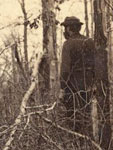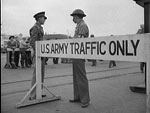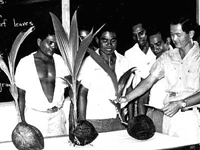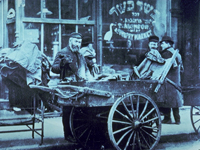Charlton's Coffeehouse
Architectural historian Ed Chappell explains the reconstruction of the Charlton Coffeehouse in Colonial Williamsburg and the function of the coffeehouse when it stood.
Architectural historian Ed Chappell explains the reconstruction of the Charlton Coffeehouse in Colonial Williamsburg and the function of the coffeehouse when it stood.
Lady Dunmore, wife of Lord Dunmore (royal governor of Virginia from 1771 to 1776), was beloved by the colonists. Interpreter Corrine Dame reflects on Lady Dunmore's life.
Relating the daily lives of America's ancestors is the product of research and performance. Performer Kat Getward shares the part that music plays in the Electronic Field Trip "Making History Live."
The Oklahoma Historical Society, with its affiliate, the Jim Thorpe Foundation, preserves and displays the former home of the 1912 Olympian containing exhibited artifacts from Jim Thorpe and his family.
The home offers tours.
The Museum houses items from actor Tom Mix's personal collection, providing a glimpse into the life of one of Oklahoma's famous figures.
The museum offers exhibits.
The 30-acre Belle Meade Plantation holds the Federal-style 1853 Belle Meade mansion and seven other historic buildings, including a stable and carriage house. The plantation was founded by John Harding in 1807. Harding was a devoted thoroughbred breeder and racer, as were many gentlemen from the South during his time. Tenneessee thoroughbred breeding became less common after the Civil War, as the state saw extensive troop movement. The mansion facade includes Greek Revival elements added in 1853, and the interior is furnished with 19th-century pieces. The plantation owned more slaves than the majority of antebellum Nashville plantations. Some of these slaves served as horse grooms and jockeys.
The plantation offers period rooms, 45-minute guided mansion tours, five educational program options for students, summer camps, home school days, traveling trunks, toddler programs, a student book club with online interactive activities, a junior docent program, culinary guided tours, and a restaurant. Reservations are required for groups of 15 or more. The second floor is not wheelchair accessible.

This is the fourth in a series of film reviews reprinted from the Journal of American History. These reviews model ways of looking critically at popular films, documentaries, miniseries, and other history-based features.
Long awaited by both historians and buffs, the film Gods and Generals is a prequel to the 1993 film Gettysburg. As Gettysburg was based on the historical novel The Killer Angels (1974) by Michael Shaara, so Gods and Generals is based on the 1998 historical novel of that title written by Shaara's son Jeff. The new film's purpose is to sketch highlights of the Civil War in the eastern theater from Virginia's secession through the death of the Confederate general Thomas J. "Stonewall" Jackson.
The need to set the stage for Gettysburg influenced the choice of what to cover in the almost four-hour-long prequel. For example, Gods and Generals covers the battle of Fredericksburg while entirely omitting the much more pivotal battle of Antietam. This omission occurs in part because Fredericksburg was the first combat experience of the key Gettysburg protagonist, Joshua Lawrence Chamberlain, and because it was the event for which the Union repulse of Pickett's charge at Gettysburg was a suitable payback. One suspects that another reason the film skips Antietam is that it led to Abraham Lincoln's issuing the Emancipation Proclamation; coverage of that document might have led viewers to suspect that the war had something to do with slavery. Of this, more anon.
Like the Civil War soldiers it depicts, the film Gods and Generals has its triumphs and its defeats. In some ways it is an improvement over Gettysburg. Robert Duvall's portrayal of Robert E. Lee is infinitely superior to Martin Sheen's glassy-eyed performance in the earlier film. The makeup is better, too, so that the viewer does not see what appear to be beavers clinging to generals' chins, as in Gettysburg. And the artillery pieces actually recoil when fired.
On the other hand, Gods and Generals perpetuates some of its predecessor's weaknesses. Actors still deliver, in spoken form, lines that their characters composed for written communication, making some scenes even more stilted than the 19th century actually was. Other scenes have the feel of that favored entertainment of the mid-Victorians, the tableau vivant—but not very vivant. Sometimes it is like watching an animated wax museum.
The greatest triumph of Gods and Generals lies in Stephen Lang's splendid depiction of Stonewall Jackson. It is difficult to imagine a more authentic and convincing presentation of the renowned general. Eschewing popular mythology that makes Jackson a wild-eyed maniac, Lang presents an understandable character that is, in almost every case, true to what we know about Jackson. This is important to Gods and Generals because Jackson's role looms so large that the film might more accurately have been titled simply Stonewall Jackson.
When they wanted to do so, the makers of Gods and Generals were accurate in both detail and nuance. Unfortunately, the filmmakers preferred to spend much of the nearly four-hour running time of the movie doing a great deal of ax-grinding. The result is the most pro-Confederate film since Birth of a Nation, a veritable celluloid celebration of slavery and treason.
Gods and Generals brings to the big screen the major themes of Lost Cause mythology that professional historians have been working for half a century to combat. In the world of Gods and Generals, slavery has nothing to do with the Confederate cause. Instead, the Confederates are nobly fighting for, rather than against, freedom, as viewers are reminded again and again by one white southern character after another.
In stark contrast, the pro-Union, antislavery view of the war is expressed only once. In one example of this unequal presentation, viewers hear the Confederate defenders of the famous sunken lane at Fredericksburg exclaiming that they are fighting for freedom and independence, but the Union attackers, members of the renowned Irish Brigade, make only trivial comments. Yet historical sources document in the Irishmen's own eloquent words why they, as immigrants, believed they ought to fight for the Union. The filmmakers did not see fit to have any of the actors mouth those lines.
Similarly, the film depicts slaves as generally happy, vaguely desiring freedom at some future date, but faithful and supportive of their beloved masters and the cause of the Confederacy. Slaveholders in the film treat their slaves like family or better, and the slaves reciprocate by doing their best to protect their masters' property from the invading Yankees. The many thousand times more numerous slaves who eagerly sought freedom and aided Union soldiers are invisible in Gods and Generals.
Another aspect of Lost Cause mythology depicted in the film deals with religion. Echoing pro-Confederate claims since the war itself, the movie represents the South as being uniquely and sincerely Christian, while the North has at most a vague spirituality. In fact, both sides had about an equal representation of Christianity. Once again, Gods and Generals presents a skewed depiction of history through judicious omission. While the film—for the most part accurately—presents Stonewall Jackson as a saint in every sense of the word, viewers never learn that Oliver O. Howard, the Union general whose troops Jackson's men so savagely attacked at Chancellorsville, was an even more fervently evangelical soldier.
Jackson's attack at Chancellorsville is the dramatic climax to the film and a neo-Confederate's dream of paradise. As Jackson rides boldly forward flanked by staff officers, the mounted party gallops toward the viewer, larger than life, and the score swells, simultaneously triumphant and otherworldly, a fittingly Wagnerian style of accompaniment for this ride of the Confederate valkyries. Any lingering doubts as to the filmmakers' sympathies promptly vanish.
The final scene at Jackson's deathbed is meant to be sad, and it is indeed very moving. Yet I left the showing quite sad in a different way. Despite the makers' large expenditures and serious efforts toward accuracy in some details, they marred the result by their willingness to perpetuate a distorted view of the Civil War.
This review was first published in the Journal of American History, Vol. 90, No. 3, 1123–1124, 2003. Reprinted with permission from the Organization of American Historians (OAH).

What constitutes the limits of dramatic license in fictional motion pictures set within the framework of a historical event? Filmmakers have regularly argued that the need for drama always outweighs the need for plausibility and historical accuracy. Audiences have generally bought the argument, as have the filmmakers themselves. Does it matter that Steven Spielberg portrays the Pentagon receiving word of the death of two Ryan brothers on Omaha Beach within two days of D-Day? Does it matter that a German fighter plane flew to the vicinity of Greenland as shown in U-571? Does it matter that Jimmy Doolittle and his raiders never flew in formation during the attack on Tokyo as shown in Pearl Harbor?
Who cares? After watching U-571, one person said, “If I want to see the truth, I will watch PBS.” But does falsifying or fabricating events add to the drama, or is good drama incompatible with truth? Clearly painting the name Enola Gay on the wrong side of the fuselage in The Beginning or the End (1947) and Above and Beyond (1952) adds nothing to the drama of Paul Tibbets's mission to drop an atomic bomb on Hiroshima. Does the mistake matter? On the other hand, portraying Tibbets as feeling guilty for carrying out his assignment, as Above and Beyond clearly does, falsifies history. Do the directors' justification that they could not show an American officer in 1952 willingly killing 80,000 people suffice?
Jonathan Mostow, director of U-571, claimed he was making a fictional story, not a documentary, about life aboard a submarine during the battle of the Atlantic and therefore he did not have to portray history accurately. Nevertheless, the British immediately took offense, claiming he was turning the Royal Navy's capture of an Enigma machine from a German submarine in 1941 into an American heist in 1942. Mostow denied he was doing this, pointing out that the British used a destroyer while he used a submarine. With U-571, the problems had less to do with history than with plausibility. The Germans did fly four-engine patrol planes over the North Atlantic but certainly not single-engine fighters. Whether an American submarine disguised as a German submarine might capture a U-boat might not be too farfetched, at least as portrayed in the movie. But having a second German submarine, in the dark of night, in a driving rainstorm recognize what was happening and figure out which one to torpedo stretches credibility beyond any realistic limits. Likewise, having the American boarding party know how immediately to start the disabled German submarine and get underway strains believability. Worse, submariners have attested to the virtual impossibility of one submarine torpedoing another submarine when both were submerged with the technology available early in the war.
U-571 remains probably the most exciting submarine movie ever made. Nevertheless, the factual and historical errors in the film prevented the director, Mostow, from fulfilling his goal of providing the contemporary generation with any real sense of life aboard a World War II submarine. His response to critics of the film: “Hey folks, it's only a movie.” In contrast, producer Jerry Bruckheimer and director Michael Bay tried to have it both ways with Pearl Harbor. On one hand, both men claimed they were making a fictional movie using the historical events only as the stage on which to create a love story. On the other hand, Bay predicted before the start of production, “You will see what happened at Pearl Harbor like you have never seen it in any other movie. Our goal is to stage the event with utmost realism.” He claimed that he wanted his Pearl Harbor movie to become one “by which all other films are measured,” dismissing Tora! Tora! Tora! (1970) as being “more of a documentary.”
To achieve these goals, Bay and Bruckheimer claimed to have read extensively in the histories about Pearl Harbor and to have interviewed many Pearl Harbor and Doolittle raid survivors. Noting that everyone had his or her own memories that did not always agree with others' on particular aspects of the Japanese attack, the filmmakers felt their re-creation was as valid as any of the recollections.
Of course, all memories are created equal, but some are more equal; where truth conflicted with drama, Bay and Bruckheimer chose to go with the drama, claiming they had captured the essence of what had happened on December 7. In fact, “essence” remains a very subjective term that can conceal a plethora of sins. One of the trailers for the film perhaps said it best: “Pearl Harbor is a fictional tale crafted from a kaleidoscope of real life personal experiences of those living through this terrifying tragedy.” The operative word is “fictional.” So little of what appears on the screen bears even a remote resemblance to actual events leading up to the attack on Pearl Harbor, the actual attack, or the aftermath, including the Doolittle raid, that audiences come away from the film with no real understanding of what happened and why. If the film's title had remained “Tennessee,” the original code name Disney gave the project to hide its actual subject, Bay and Bruckheimer, like Mostow, could have hidden behind the claim that they were only making a dramatic movie, not a documentary.
However, the title Pearl Harbor and Bay's predictions about what he intended to do strongly suggest the film is providing a reasonably accurate account of what happened on December 7. Historians have to be careful to criticize the elephants, not the ants, when discussing the dramatic license filmmakers take in their movies. But audiences have to know little or nothing about Pearl Harbor to recognize the errors or fabrications. In view of the recent attention given to President Franklin D. Roosevelt because of the dedication of his memorial, most people understand that he simply could not stand up unaided, as happens in the movie.
Likewise, since the movie portrays the growing tensions between Japan and the United States and relates at least superficially the plans for the attack on Pearl Harbor, audiences are going to wonder how one of the heroes could manage to get permission to fly his P-40 over Pearl Harbor at dusk. While Bay commented with pride about the film's signature shot of a bomb falling slowly downward toward the Arizona, people recognize the hokiness of the sequence even if they do not know that the battleship was hit after the Oklahoma, not before, as portrayed.
In fact, the reviewer has compiled a five-page list of “flaws” in Pearl Harbor. Do they matter? Only to the extent that truth itself matters. For most historians the liberties the filmmakers took with the facts render Pearl Harbor useless as a tool to teach students about the Japanese attack. From the Japanese perspective, however, the film has a significant upside. Most people went to see Pearl Harbor for the love story and the explosions and so left the theater without any significant antagonism toward those friendly people who brought the United States into World War II and later began making fine cars, cameras, television sets, and video recorders.
This review was first published in the Journal of American History, 88 (3) (2001): 1208–1209. Reprinted with permission from the Organization of American Historians (OAH).
To browse all of Teachinghistory.org's materials on Pearl Harbor, try our spotlight page: In Remembrance: Pearl Harbor. (Browse our full selection of spotlights on historic events and commemorations here.)

This website offers more than 50,000 slides and photographs that document the history of the American period in Micronesia from 1947 to 1988. The image collection can be browsed or the visitor can sample the types of images in the collection through 12 short animated image tours. The topics of the image tours give an idea of the variety of images available in the collection: parades, dancing, voting, agriculture, stone money, canoes, architecture, women, leaders, education and children, health and hospitals, and men. The only search capability on the site is a Google search of the photograph description files. Additional resources include a map of Oceania and a link to the Hawaii War Records Archive. This archive is a useful source of images for those researching, writing, or teaching the cultural history of the Pacific Islands.

A gateway and an archive of numerous articles on New York history, this site "focuses a particularly long lens on the early history of political and economic events, panics, riots and other related matters affecting or contributing to New York City's development and growth." Its main feature is the New York state and New York City directories. (The U.S. directory is currently unavailable.) The New York state directory offers more than 700 links and more than 60 articles organized under 21 topics that include the arts, cities and counties, ethnic groups, military, societies and associations, transportation, women and their professions, and worship.
The New York City directory offers more than 5,200 links and more than 700 articles organized under 58 topics that include architecture, the arts, business matters, city government, clubs and societies, crime and punishment, education, ethnic groups, 5th Avenue, Harlem, immigration, New York City panics, real estate, temperance and prohibition, and Wall Street. The visitor can search the entire site or each directory by keyword. This site is a good starting point for researching the history of New York. It should also be useful for literary scholars, writers, and historical societies.